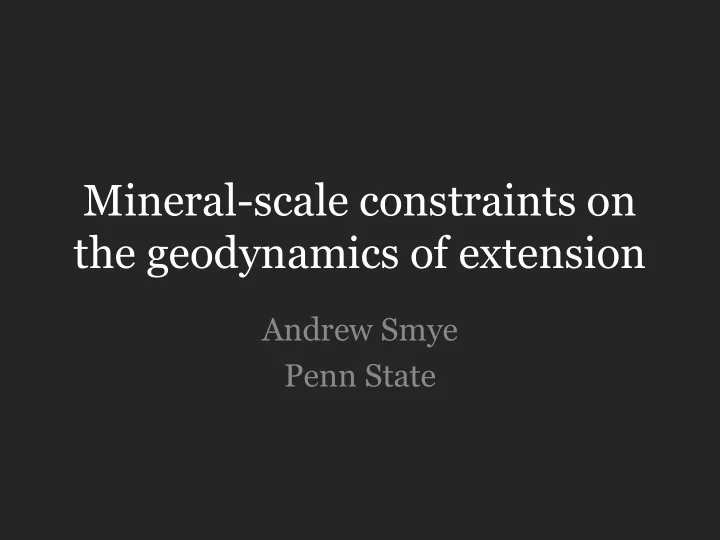

Mineral-scale constraints on the geodynamics of extension Andrew Smye Penn State
Acknowledgements UT Austin UT Austin Göteborg, Sweden + Cat Krispin (PSU), Spencer Seman (PSU),
Motivation & Outline 1. How is strain vertically distributed during rifting? Huismans & Beaumont 2014 2. What are typical rates of mantle cooling/upwelling during extension? Lavier, unpub. Approach: use high-T thermochronology and diffusion speedometry to harness thermal signature of geodynamics
1. Strain distribution and thermal history → Uniform thinning (pure shear) β = 5 15 Ma 1 Ma intervals T m = 1400 °C McKenzie 1978
1. Strain distribution and thermal history → Depth-dependent thinning δ = 3 β = 15 15 Ma 1 Ma intervals T m = 1400 °C Royden & Keen 1980
1. Strain distribution and thermal history • Uniform thinning drives cooling at all structural levels • Partitioning of strain into mantle lithosphere drives conductive heating of lower/middle crust • Is this signal recorded in attenuated lower crust?
1. Strain distribution and thermal history → Application: attenuated lower crust; Ivrea Zone, Italy ~ 6 kbar, Mu+Qtz ~ 8 kbar, Gt+Kfs+Sill+melt
1. Strain distribution and thermal history Rutile U-Pb thermochronology, Ivrea Zone → zircon 276 Ma rutile 274 Ma 189 Ma garnet • Zircon texturally younger than rutile, yet >90 Ma older • U-Pb rutile system reset ~180-190 Ma
1. Strain distribution and thermal history → Rutile U-Pb thermochronology, Ivrea Zone Smye & Stockli 2014, EPSL
1. Strain distribution and thermal history → Rutile U-Pb thermochronology, Ivrea Zone Handy et al. (1999) 4 km depth interval of granulites (at 20 ° C/km ∆ T is 80 ° C) • • 5 ° C/Ma cooling, 40 Ma age spread is expected • Elevated dT/dz at onset of rift-related exhumation, ~180 Ma
1. Strain distribution and thermal history Revised thermal history, Ivrea Zone →
1. Strain distribution and thermal history Revised thermal history, Ivrea Zone →
1. Strain distribution and thermal history High-magnitude thinning of the lithospheric mantle → β=4 Thermal history consistent with preferential thinning of lithospheric mantle (δ:β > 1:4)
2. Rates of mantle cooling/upwelling Duration of rifting critical for melt generation (Bown & White 1995) → β = 10
2. Rates of mantle cooling/upwelling Duration of rifting critical for melt generation (Bown & White 1995) → β = 5 β = 10 β = 15 Cooling rate of lithospheric mantle is a good indicator of melt generation → during extension
2. Rates of mantle cooling/upwelling Lanzo peridotite massif, Italy → Piccardo et al 2009
2. Rates of mantle cooling/upwelling Porphyroclastic peridotites of exhumed lithospheric mantle →
2. Rates of mantle cooling/upwelling Diffusional equilibration of opx during mantle upwelling →
2. Rates of mantle cooling/upwelling Diffusional equilibration of opx during mantle upwelling → Cherniak & Liang 2007
2. Rates of mantle cooling/upwelling Diffusional equilibration of opx during mantle upwelling → Cherniak & Liang 2007
2. Rates of mantle cooling/upwelling Cooling rate determination by opx speedometry →
2. Rates of mantle cooling/upwelling Implications of slow cooling, Lanzo peridotite body → 10 °C/Ma cooling of lithospheric mantle achieved when β=5; slow → enough to suppress melt generation β = 5 T m = 1330°C
Conclusions 1. U-Pb thermochronology and diffusion speedometry afford opportunity to recover thermal history information relevant to extension. 2. Lower crust of Adriatic margin underwent reheating ~180 Ma, contemporaneous with the onset of mantle exhumation. 3. Adriatic lithospheric mantle cooled at ~10 °C/Myr, slow enough to suppress significant melt generation.
Recommend
More recommend